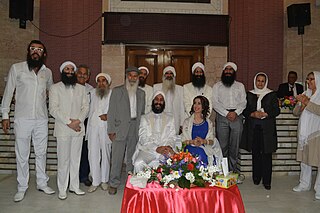


| Part of a series on |
| Mandaeism |
|---|
 |
| Religion portal |
The skandola (also sakin dola or sakin ḏ-ula, [1] literally "dwelling of evil" in Mandaic) is a ritual talismanic seal used by Mandaeans to protect against evil. [2] : 37



| Part of a series on |
| Mandaeism |
|---|
 |
| Religion portal |
The skandola (also sakin dola or sakin ḏ-ula, [1] literally "dwelling of evil" in Mandaic) is a ritual talismanic seal used by Mandaeans to protect against evil. [2] : 37
The skandola is an iron ring with a chain attached to an iron knife. It is used as a sacred talismanic seal. It is used to seal graves and also newborn babies on their navels. During wedding ceremonies, a priest gives the skandola to the bridegroom. There are incised depictions of the following animals: [2]
E. S. Drower notes parallels with Mithraic bas-reliefs, Yazidism, Iranian artistic symbols, and others. A Mandaean priest told Drower that the skandola was originally brought by Hibil Ziwa from the World of Darkness as he was taking Ruha along with him (a narrative found in Book 5, Chapter 1 of the Right Ginza [3] ). [2]
Adam Kasia means "the hidden Adam" in Mandaic. The hidden Adam is also called Adam Qadmaiia. In Mandaeism, it means the soul of the first man. He is also identified as Shishlam, the primordial priest.
In Mandaeism, ʿUr is the king of the World of Darkness or underworld. He is the son of Ruha, the queen of the underworld, and her brother Gaf, one of the giants in the World of Darkness described in book 5 of the Ginza Rabba. Ur is typically portrayed as a large, ferocious dragon or snake. He is represented by the image of a serpent on the skandola talisman.
A ganzibra is a high priest in Mandaeism. Tarmidas, or junior priests, rank below the ganzibras.
In Mandaeism, Shishlam is a figure representing the prototypical Mandaean priest or Mandaean. He is also frequently referred to in Mandaean texts as Šišlam Rabba (Classical Mandaic: ࡔࡉࡔࡋࡀࡌ ࡓࡁࡀ, romanized: Šišlam Rba, lit. 'Great Shishlam'. Shishlam is sometimes identified with Adam Kasia, the "Perfect Man".

The drabsha or darfash is the symbol of the Mandaean faith. It is typically translated as 'banner'.
In Mandaeism, Adathan and Yadathan are a pair of uthras who stand at the Gate of Life in the World of Light, praising and worshipping Hayyi Rabbi. In the Ginza Rabba and Qolasta, they are always mentioned together. Book 14 of the Right Ginza mentions Adathan and Yadathan as the guardians of the "first river".

An andiruna is a temporary reed hut used during Mandaean priest initiation ceremonies.
In Mandaeism, Yawar Ziwa is an uthra from the World of Light. He is the personification of light.
In Mandaeism, Hag and Mag are a pair of demons that are usually mentioned together. Hag is a male demon, while Mag is a female demon. Hibil Ziwa encounters Hag and Mag during his descent to the World of Darkness in Chapter 1 of Book 5 in the Right Ginza, where they are described as "the two manas of darkness." Hag is represented by the image of a scorpion on the skandola talisman.

In Mandaeism, zidqa refers to alms or almsgiving. Mandaean priests receive regular financial contributions from laypeople, since priesthood is typically a full-time occupation. Zidqa is also offered to the poor and needy.
The Feast of the Great Shishlam or Dehwa d-Šišlam Rabba or Nauruz Zūṭa is a Mandaean religious holiday that takes place on the 6th and 7th days of Daula, the first month of the Mandaean calendar. It is named after Shishlam, the Mandaean personification of the prototypical priest.

In Mandaeism, various beings inhabit the World of Darkness.

The qabin is the Mandaean wedding ritual. Mandaean weddings are typically held for several days. Traditionally, weddings must be officiated by a Mandaean priest and can only be performed for ethnic Mandaeans, although this has proved to be challenging for the contemporary Mandaean diaspora.
Mandaean names can include both birth names and baptismal names, called malwasha (ࡌࡀࡋࡅࡀࡔࡀ) in Mandaic.
In Mandaeism, Nbaṭ is an uthra who is described as the "King of Air" or the "first great Radiance." He is also called Nbaṭ Rba or Nbaṭ Ziwa "the Radiant Nbaṭ", literally "Radiance Burst Forth". In The Thousand and Twelve Questions , he is also known as Kušṭa Yaqra "Solemn Truth".
Shihlun is an uthra in the World of Light. In the Mandaean Book of John, he is noted for his opposition to the creation of the material universe by Ptahil and his assistant uthras.
In Mandaeism, Nṣab is an uthra. He is also called Nṣab Rba or Nṣab Ziwa. Nṣab and Anan-Nṣab are frequently mentioned together as a pair in the Right Ginza and Qolasta.
Zihrun, is an uthra in the World of Light. He is the main subject of the Mandaean scroll Zihrun Raza Kasia.
In Mandaeism, Tarwan is a section of the World of Light that is typically described as a "pure land."
In Mandaeism, an anana is a heavenly cloud in the World of Light that is considered to be the dwelling place of uthras. An anana can also be interpreted as a female consort.